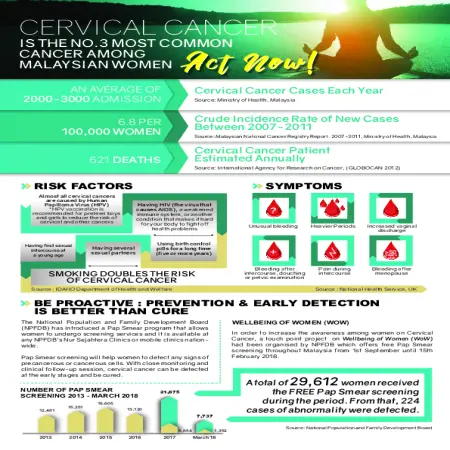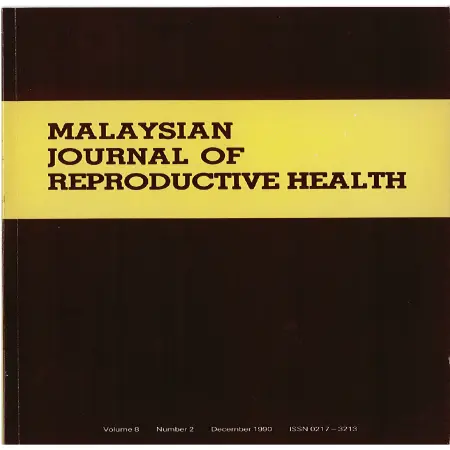Browse by Subject
Results for Search : "610 Medicine & health"
|
|
Cepat Tahu, Cepat Tindak
Item Type: Video
Editor:
Year: 00/01/2023
Abstract: Educational video regarding the importance of undergoing a mammogram test which is an examination to detect the early stages of breast cancer while the HPV DNA test is a test to detect the Human Papillomavirus (HPV) that is infected through sexual contact. Cervical cancer is cancer at the base of the uterus caused by HPV.
|
|
|
|
|
|
Cervical cancer
Item Type: Infographic
Editor:
Year: 00/05/2018
Abstract: This infographic describes information about cervical cancer. Cervical cancer is the no.3 most common cancer among Malaysian women. Almost all cervical cancers are caused by Human Papilloma Virus (HPV). The symptoms such as unusual bleeding, heavier periods and bleeding after menopause.
|
|
|
|
|
|
Cytotoxicity and expression profiles of apoptosis gene related in human cervical cancer (HeLa) cell lines in response to Newcastle disease virus (NDV) strains AF2240 And V4-UPM
Item Type: Thesis
Editor:
Year: 01/01/2011
Abstract: In this study the cytotoxicity and expression profiles of apoptosis gene related in human cervical cancer (HeLa) cell lines in response to Newcastle disease virus (NDV) strains AF2240 and V4-UPM were studied. NDV is a strain of avian paramyxovirus. NDV has been classified into the order Mononegavirales, family Paramyxoviridae, subfamily Paramyxovirinae and genus Rubulavirus. NDV caused severe economic losses in the poultry industry worldwide. Several local strains of Newcastle disease virus were reported to induce cytolysis to the cancerous cell lines. Strain AF2240 is a heat resistant viscerotropic velogenic NDV and strain V4-UPM is a heat resistant lentogenic which has significant higher thermostabilities of infectivity and haemagglutination were reported cytolysis leukemic cells in vitro and has shown in vivo anti leukemic agents . In this study the cytotoxicity effects of strains of NDV AF2240 and V4-UPM towards HeLa cell were determined by using standard microtetrazolium assay (MTT). Cytotoxicity dose 50% (CD50) cells treated with different titre of NDV as haemagglutination units (HAU) as compared to the untreated cells was estimated at 72 hours post-infection. The CD50 values obtained were 0.95 HAU and 1.0 HAU for strains AF2240 and V4-UPM, respectively. No cytolytic effect was noted towards normal cells (3T3) was observed. Both strains were also observed to inhibit HeLa cell proliferation. Morphological observations also have been done under inverted light and fluorescence microscopes. Under the inverted light microscope, the HeLa cells treated with both strains showed apoptotic features such as cell shrinkage, cell blebbing and formation of apoptotic bodies. Morphological features of apoptosis were also observed by using the AO/PI staining method under the fluorescence microscope. The AO/PI staining demonstrated the occurrence of apoptosis which was characterised mainly by chromatin condensation, nuclear shrinkage and formation of apoptotic bodies. Evidently, both strains AF2240 and V4-UPM used in the study were found to induce cells towards apoptosis rather than necrosis. NDV strain AF2240 and strain V4-UPM was also caused genotoxic in HeLa cells after two hours treatment with CD10 and CD25 values by alkaline comet assay. Results showed that HeLa cells treated with NDV strains AF2240, V4-UPM and hydrogen peroxide gave different distribution of scores. The HeLa cells treated with hydrogen peroxide as a positive control gave more percentage at score 2, 3 and 4 for both cytotoxicity values compared to the HeLa cells treated with NDV for both strains. Observation in this study has proved the genotoxic potential of the NDV strains AF2240 and V4-UPM to induce DNA damage on HeLa cells as early as two hours following treatment at very low cytotoxicity dose (CD10 and CD25) values. Meanwhile, the cell cycle analyses of HeLa cells treated with local strains of NDV AF2240 or V4-UPM did not induce cell cycle arrest in any specific phase. Sub-G1 phase (apoptosis peak) was found in both treated cells with a very high percentage compared to untreated cells with a small percentage. The results indicate that, the percentages of apoptosis were significantly increased (p≤0.05) in the time-dependent manner in both NDV strains treated HeLa cells. The molecular mechanisms of apoptosis may depend on the NDV strain and cell type. Six apoptosis genes were selected in this study namely Casp8, TNF-α, Bcl2 and TRAIL which focused on extrinsic pathway of apoptosis, while the gene Bax was used as an indicator for intrinsic pathway triggered by cellular stress. Lastly Myc, oncogene was used as an indicator for cell growth. From this study, NDV strain AF2240 was identified as a highly induced death receptor pathway due to the upregulation of TNF gene and the downregulation of Bax gene. Whereas NDV strain V4-UPM triggered both pathways but through the extrinsic pathway due to the very high expression of the TNF gene. The TNF gene was highly expressed due to its location and function as a stimulator of the death receptor pathway. The Casp8 gene was activated and expressed in order to enter the execution-phase of cell death. The Bcl-2 gene was continuously observed because of its function as an apoptosis regulator. Surprisingly, no expression was detected by the TRAIL gene. NDV strain AF2240 was more effective than NDV strain V4-UPM as an apoptosis inducer. These gene expression results showed that the apoptosis occurred and lead to cell death.
|
|
|
|
|
|
Coagulation profile in women on low-dose oral contraceptive pills
Item Type: Article
Editor:
Year: 00/12/1990
Abstract: A cross-sectional study looking at the coagulation system was carried out involving 175 women attending the National Population and Family Development Board's Clinic at the Maternity Clinic, General Hospital, Kuala Lumpur. Study subjects comprise of 50 combined low-dose estrogen/progesterone oral contraceptive (OC) pill users and 75 non-OC users, acting as controls. The subjects were on the pill for a period of one year or more. There were significant shortening of the prothrombin time (PT) and partial thromboplastin time (PTT) in the OC group as compared to the control group. However, the activities of factors II, V and VII assayed were not significantly different between the two groups, suggesting that the changes in the PT and PTT were not significant clinically. The effect of long term usage of combined low-dose OC pills does not seem to indicate changes in the coagulation profile of the women in our study.
|
|
|
|
|
|
Comparative study on the acceptance and use of contraceptive methods in a rural population in Kelantan
Item Type: Article
Editor:
Year: 00/12/1990
Abstract: The generally poor health indices for Kelantan and the strong cultural beliefs with reference to contraception dictated the need for this study. 350 women from neighbouring estates were studied via questionaires. It was found that only 44.85% use some form of contraception and 18.4% of these resorted to traditional methods. There was some relationship between race and choice of contraception. Education did play a role in encouraging contraception. Despite the low acceptance of contraception, spacing of children did exist-probably due to breastfeeding that's widely practised.
|
|
|
|
|
|
Clinical evaluation of Buserelin, a GnRH analogue in the management of moderate to severe pelvic endometriosis
Item Type: Article
Editor:
Year: 00/12/1990
Abstract: A local study, a part of a multinasional and multicenter study on the efficacy and safety of Buserelin was carried out for the treatment of pelvic endometriosis using a standard protocol. 20 women diagnosed to have moderate to severe endometriosis by laparoscopy were recruited. The women were given 900 micrograms Buserelin acetate daily by intranasal spray for a fixed period of 6 months. Baseline hormonal and biochemical parameters were taken prior to treatment and the parameters were repeated during each follow-up at weekly and monthly intervals. In addition, changes in symptoms were monitored. A second look laparoscopy was performed at completion of therapy and patients were followed up for a further 6 months. There was 100 percent suppression of oestradiol levels during the 6 months treatment period. An improvement of implants according to AFS classification occured in all patients. One patient discontinued because of side effects. Restoration of cycles after completion of therapy occured within 7 weeks. There were 7 pregnancies (64%) in the first 6 months after treatment for those wanting pregnancies. During therapy, dysmenorrhoea, pelvic pain and dyspareunia improved considerably. Buserelin was proven to be effective in the management of pelvic endometriosis and is well tolerated and safe.
|
|
|
|











